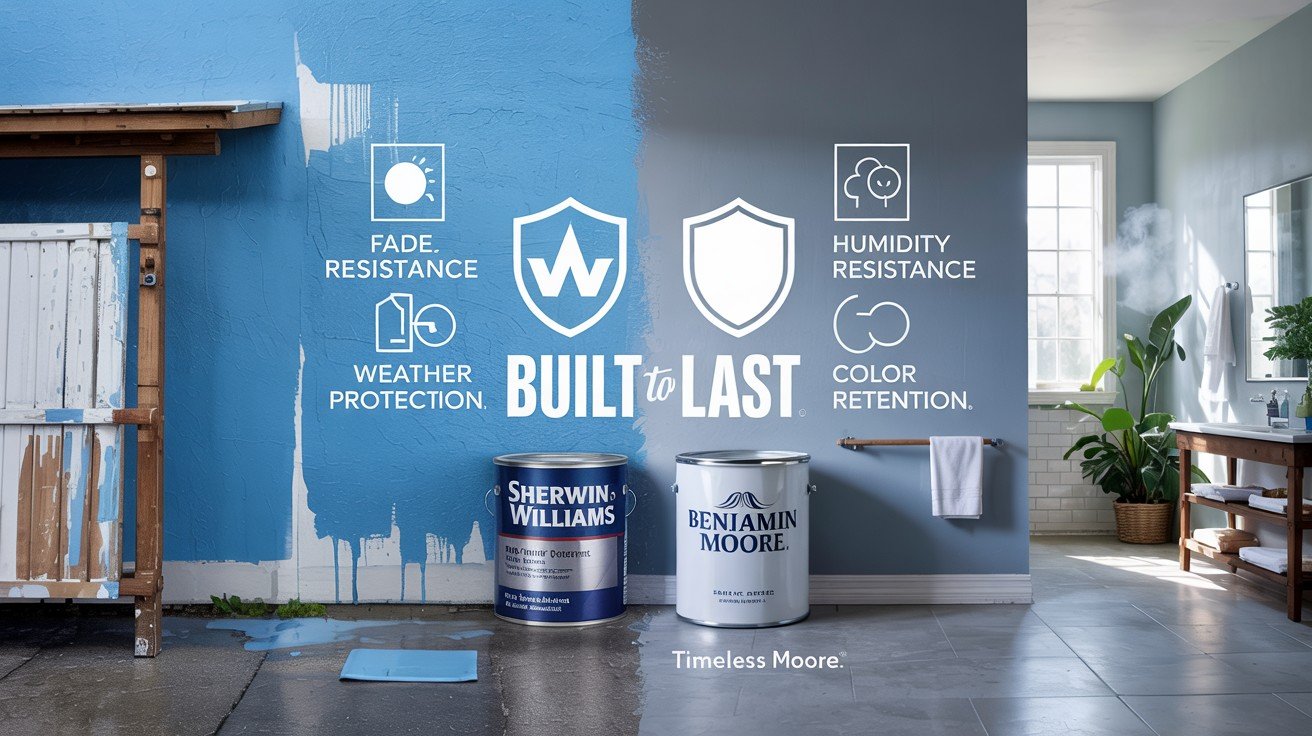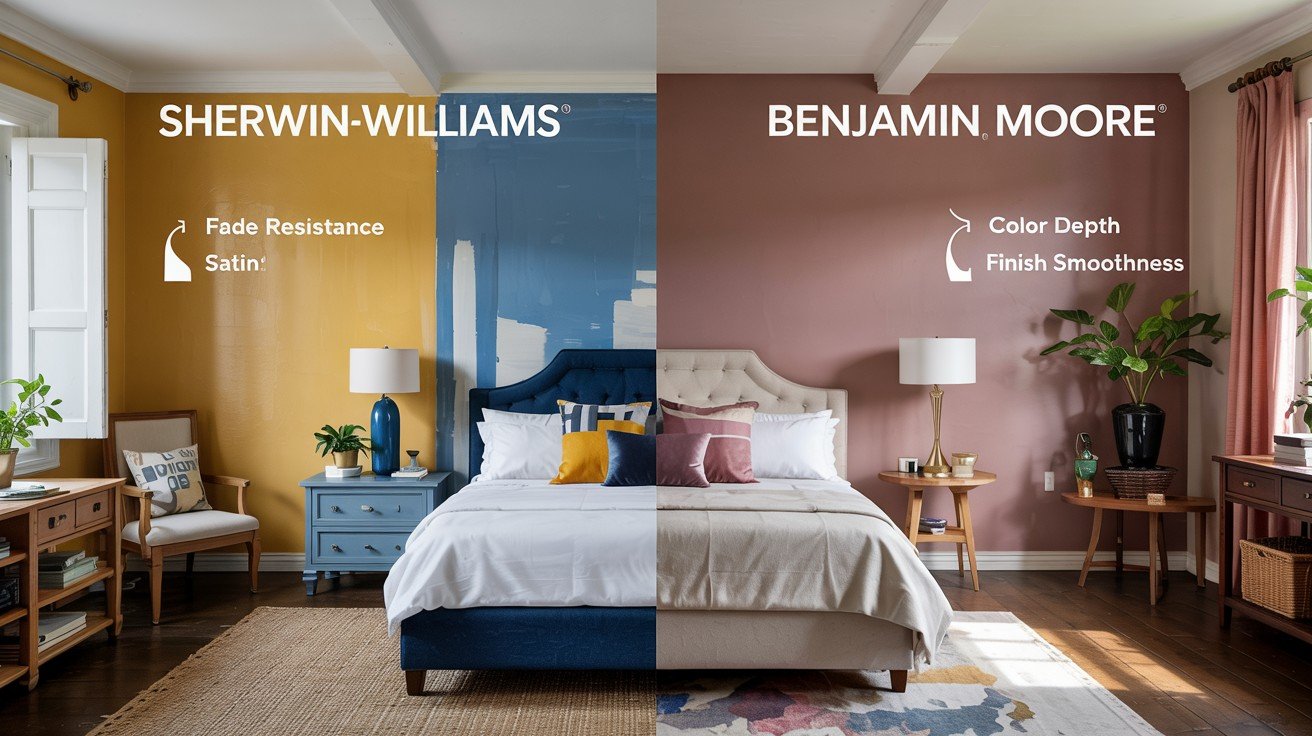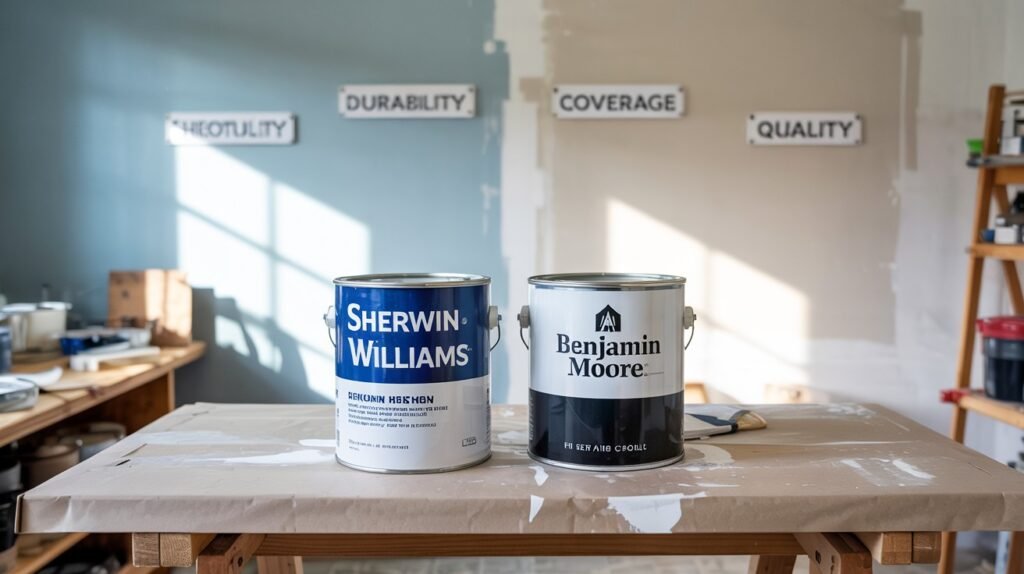Are you stuck between two paint giants and can’t decide which one deserves your hard-earned money?
Choosing the right paint brand can make or break your home improvement project.
When it comes to premium paint options, the “Sherwin-Williams vs Benjamin Moore” debate has been dividing homeowners and professionals for decades.
Both brands promise exceptional quality, but they each have distinct strengths that matter depending on your specific needs.
Maybe you’re planning a complete interior makeover, tackling an exterior refresh, or simply touching up a few rooms.
The paint you choose will impact everything from application ease to long-term satisfaction.
Let’s cut through the marketing claims and examine what sets these two industry leaders apart.
By the end, you’ll know exactly which brand aligns with your project goals, budget, and expectations.
Durability Comparison

Sherwin-Williams
Sherwin-Williams excels in high-traffic environments, with its Emerald line offering exceptional scuff and stain resistance.
Duration exterior paint consistently outperforms competitors in fade resistance and weather protection, often lasting 10-15 years without significant deterioration.
Their advanced acrylic formulations handle temperature fluctuations well, making them reliable for demanding commercial and residential applications.
Benjamin Moore
Benjamin Moore’s Aura line demonstrates impressive longevity, maintaining color vibrancy and finish integrity for years.
Their paints show excellent scuff resistance in busy households and perform exceptionally well in humid conditions like bathrooms and kitchens.
The brand’s superior binding agents help resist cracking and peeling, even in extreme temperature variations.
Verdict
Both brands offer comparable durability in their premium lines. Sherwin-Williams edges ahead for exterior applications and commercial use, while Benjamin Moore excels in interior environments requiring long-term color stability and finish retention.
Coverage and Ease of Application
Sherwin-Williams
Sherwin-Williams paints typically require fewer coats due to their thicker consistency and high pigment load.
Most premium lines achieve full coverage in two coats, even over darker surfaces. The paint flows smoothly with both rollers and brushes, reducing streaking and lap marks.
Professional painters appreciate the extended open time, which allows for better blending and touch-ups during application.
Benjamin Moore
Benjamin Moore excels at dramatic color changes, often covering dark walls with lighter colors in just two coats. Their self-priming formulas reduce preparation time significantly.
The paint applies easily for DIYers, with minimal spattering and excellent flow characteristics.
However, some lines may require an additional coat when transitioning from very dark to very light colors compared to Sherwin-Williams.
Verdict
Sherwin-Williams takes the lead for overall coverage efficiency, particularly with their premium lines requiring fewer coats.
Benjamin Moore offers superior user-friendliness for DIYers but may need extra coats in challenging color transitions.
Availability & Store Experience
Distribution Network Comparison
|
Distribution Factor |
Sherwin-Williams |
Benjamin Moore |
|
Store count |
4,900+ dedicated stores |
5,000+ independent retailers |
|
Geographic coverage |
Nationwide presence |
Varies by region |
|
Store type |
Company-owned locations |
Independent paint stores |
|
Consistency |
Standardized experience |
Variable by retailer |
Shopping Experience
|
Experience Factor |
Sherwin-Williams |
Benjamin Moore |
|
Staff expertise |
Trained company employees |
Variable retailer knowledge |
|
Product availability |
Guaranteed stock levels |
Depends on the retailer’s inventory |
|
Color matching |
Professional equipment in-store |
Quality varies by location |
|
Hours of operation |
Standard retail hours |
Often extended local hours |
Service & Support
|
Service Aspect |
Sherwin-Williams |
Benjamin Moore |
|
Technical support |
Dedicated reps available |
Through a retailer relationship |
|
Bulk ordering |
Direct company pricing |
Retailer-dependent discounts |
|
Delivery options |
Company fleet delivery |
Local retailer delivery |
|
Return policy |
Standardized corporate policy |
Individual store policies |
Convenience Factor
|
Shopping Consideration |
Sherwin-Williams |
Benjamin Moore |
|
Accessibility |
Easier to find locations |
May require searching |
|
One-stop shopping |
Complete paint supplies |
Full-service paint stores |
|
Brand consistency |
Identical experience everywhere |
Personalized local service |
Comparison Tip: Check your local area for Benjamin Moore retailers versus Sherwin-Williams stores. Urban areas typically have both options, while rural locations may favor one brand’s distribution network.
Paint Quality and Finish Options

Sherwin-Williams
Sherwin-Williams delivers consistent finish quality across its product range, with excellent pigment richness that maintains vibrancy over time.
Their fade resistance technology performs exceptionally well, particularly in sun-exposed areas. The brand offers a wide spectrum of sheen levels, from flat to high-gloss, with reliable consistency between batches.
Color matching accuracy remains strong across different lighting conditions.
Benjamin Moore
Benjamin Moore stands out for exceptional color depth and sophisticated undertones that create rich, complex finishes.
Their paints produce remarkably smooth surfaces with minimal brush marks or roller stipple. The brand’s finish retention over time surpasses many competitors, maintaining the original sheen and texture years after application.
Their color formulation technology creates more nuanced, designer-quality results.
Verdict
Benjamin Moore wins for overall visual appeal and finish sophistication, offering superior color depth and smoothness.
Sherwin-Williams provides more consistent results across price points and better fade resistance, making it ideal for practical applications requiring long-term color stability.
Cost and Value for Money
Price Points Comparison
|
Product Tier |
Sherwin-Williams |
Benjamin Moore |
Price Difference |
|
Premium |
Emerald ($65-75/gal) |
Aura ($70-80/gal) |
BM +$5-10 higher |
|
Mid-Range |
SuperPaint ($45-55/gal) |
Regal Select ($55-65/gal) |
BM +$10 higher |
|
Entry-Level |
ProMar 200 ($35-45/gal) |
Ben ($45-55/gal) |
BM +$10 higher |
Longevity vs Price Value
|
Factor |
Sherwin-Williams |
Benjamin Moore |
|
Cost per year (Premium) |
$4.50-5.00 |
$4.70-5.30 |
|
Repainting frequency |
12-15 years |
12-15 years |
|
Touch-up needs |
Moderate |
Lower |
|
Overall value rating |
Excellent |
Very Good |
Professional vs DIY Assessment
|
User Type |
Sherwin-Williams |
Benjamin Moore |
|
Professional contractors |
Better bulk pricing, wider availability |
Higher margins, premium positioning |
|
DIY homeowners |
More affordable, easier access |
Superior finish quality, fewer mistakes |
|
Best value choice |
Budget-conscious projects |
High-end applications |
Verdict: Sherwin-Williams offers better overall value for most applications, while Benjamin Moore justifies its premium pricing for luxury projects requiring exceptional finish quality.
Which One Should You Choose?
Interior Walls: Benjamin Moore wins for color depth and smooth application, especially in living spaces where aesthetics matter most.
Exterior Paint Jobs: Sherwin-Williams Duration offers superior weather resistance and longevity, making it ideal for harsh climates and high-exposure areas.
Cabinets and Trim: Benjamin Moore’s Advance provides exceptional smoothness and durability for detailed work, while Sherwin-Williams ProClassic offers comparable results at a lower cost.
Rental Properties: Choose Sherwin-Williams for budget-friendly options that still provide decent coverage and durability without premium pricing.
Forever Home: Benjamin Moore justifies the extra cost with superior color sophistication and finish quality that you’ll appreciate daily.
Bottom Line: Benjamin Moore excels in aesthetics and interior applications, while Sherwin-Williams offers better value and exterior performance for practical needs.
Conclusion
The Sherwin-Williams vs Benjamin Moore decision ultimately depends on your specific project needs and priorities.
Benjamin Moore excels when aesthetics and color sophistication matter most, making it perfect for high-end interior projects and forever homes where you’ll appreciate the superior finish quality daily.
Their paints offer exceptional smoothness and color depth that justify the premium pricing.
Sherwin-Williams provides outstanding value for practical applications, especially exterior projects requiring maximum durability and weather resistance.
Their widespread availability and consistent quality make them ideal for contractors and budget-conscious homeowners without sacrificing performance.
Both brands deliver professional-grade results in their premium lines. Consider Benjamin Moore for interior spaces where visual appeal is paramount, and choose Sherwin-Williams for exterior applications, rental properties, or when balancing quality with cost-effectiveness.
Your specific project requirements should guide this important decision.
Frequently Asked Questions
Can I use Benjamin Moore and Sherwin-Williams paints together on the same project?
Yes, but ensure compatible primers and allow proper curing time between different brands for optimal adhesion.
Which brand offers better color matching for touch-ups years later?
Benjamin Moore typically maintains better color consistency over time, making future touch-ups more accurate and seamless.
Do professional painters prefer one brand over the other?
Most professionals choose based on project type: Benjamin Moore for high-end interiors, Sherwin-Williams for exterior durability.

